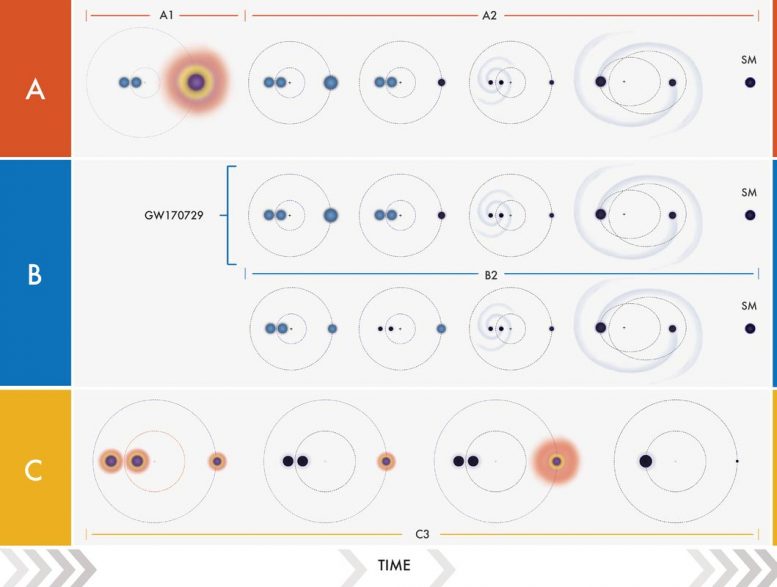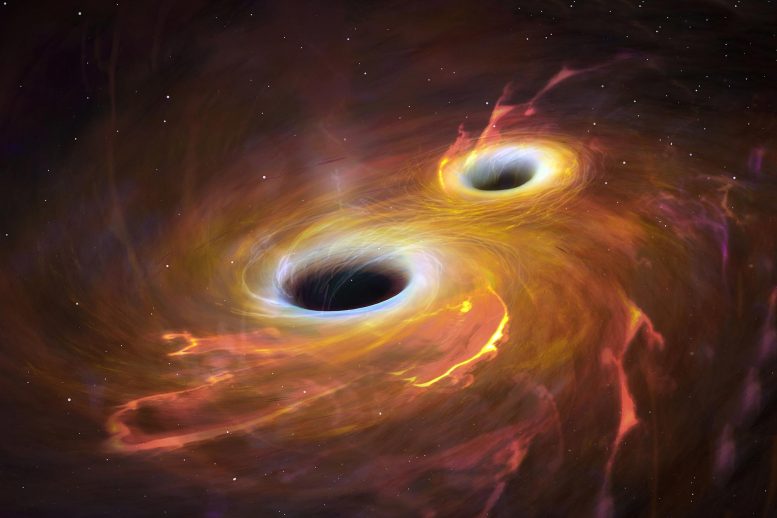The merger of two black holes in a binary system emits energy that can be detected on Earth by gravitational-wave observatories. The LIGO Scientific Collaboration and the VIRGO Collaboration have announced tens of confident detections of such mergers to date. Now, one of the main questions we can try to address concerns the origin of such merging binaries: do they come from isolated binary stars or from dense stellar environments? The answer might not be that simple.
A recent study published in the Astrophysical Journal Letters, led by OzGrav Alumni (Monash University) Dr. Alejandro Vigna-Gómez—and current DARK Fellow at the Niels Bohr Institute—shows that some binary black holes can originate from triple stellar systems. A triple stellar system consists of an inner binary and a triple stellar companion orbiting around it. If the inner binary is close enough, it can become a binary black hole which rapidly merges. The product of a binary black hole merger is a single rotating black hole. The merger of the inner binary black hole transforms the initial triple system to a binary, which itself might be able to merge within the age of the Universe. However, the assembly of these triple systems is not as simple as it sounds, as they need to be formed at low metallicities.

Time evolution of massive stellar triples: The figure illustrates compact stars in blue, standard evolving stars with red envelopes, black holes in black and merging binary black holes with a surrounding swirl. Black holes formed as sequential mergers are labeled “SM.” Top: the outer tertiary is the most massive star in the system and forms the first black hole in this triple. The inner binary needs to be constituted of compact stars and the tertiary can be either standard evolving or a compact star. Middle: all stars have similar masses. These triples can only lead to sequential mergers if all stars are compact. GW170729 might have experienced this evolution. Bottom: the tertiary is of significantly lower mass than either of the inner binary stars. This configuration does not lead to sequential mergers and is only presented for completion. Credit: T. Rebagliato & A. Vigna-Gomez
Astronomers consider metals to be all elements except hydrogen and helium. Low metallicity environments are those in which hydrogen and helium compose more than approximately 99% of matter. Scientists believe that rare compact stars exist in low metallicity environments. In these environments, rapid rotation and mixing stir the stellar fuel and restrict chemically homogeneously-evolving stars from expanding. Additionally, metallicity increases alongside the age of the Universe, and therefore compact stars are more likely to be formed in the distant past.
Vigna-Gómez and collaborators studied the properties of such sequential binary black hole mergers and conclude that GW170729, one of the detected signals of a binary black hole merger, might be of triple stellar origin. The progenitor of GW170729 has at least one rapidly spinning black hole, plausibly from a previous merger.
Moreover, the masses are consistent with those of chemically homogeneously evolving stars, and the inferred formation time coincides with the time it would take a triple system to experience two sequential mergers. Future observations from gravitational-wave observatories will help to further probe this formation channel and, more in general, understand the origin of binary black hole mergers.










…
The merger of two black holes in a binary system emits energy that can be detected on Earth by gravitational-wave observatories. The LIGO Scientific Collaboration and the VIRGO Collaboration have announced tens of confident detections of such mergers to date. Now, one of the main questions we can try to address concerns the origin of such merging binaries: do they come from isolated binary stars or from dense stellar environments?…
… could it come from both, and one way you get one type and another way you get another type…
… could it be that according to the way it has became into existence there are different types of black wholes, and different types can merge …